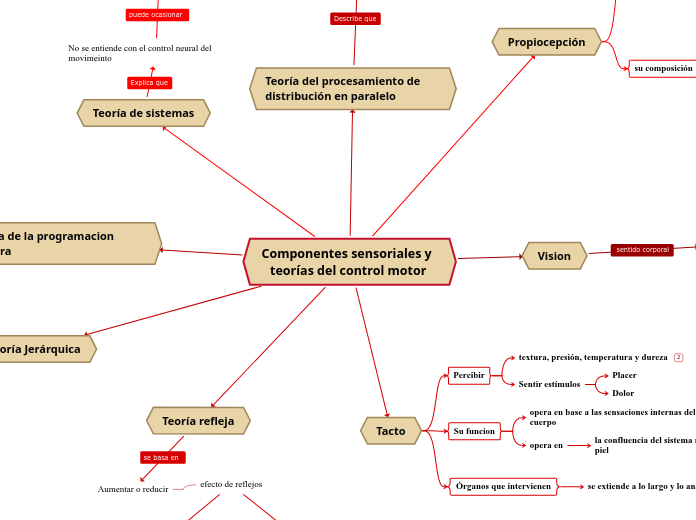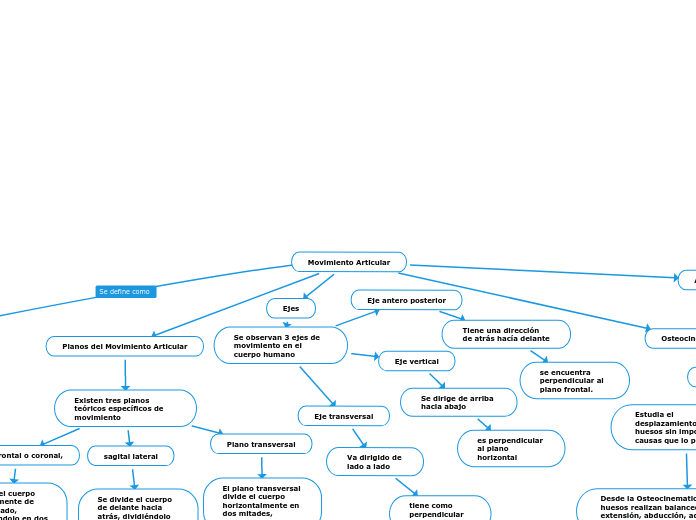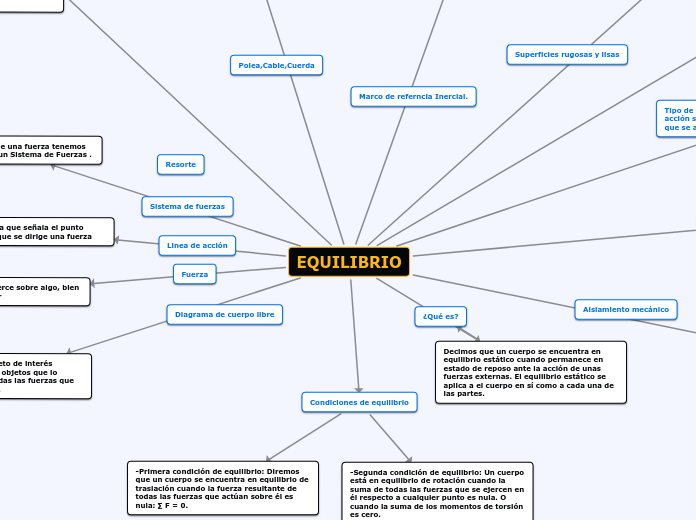Componentes sensoriales y teorías del control motor
To name your story, you have to think about the overall message and what you want your audience to understand from the story. Also, make it relevant and easy to remember.
Teoría del procesamiento de distribución en paralelo
El sistema nervioso
El ordenador
interactuar de diversas formas
Actuar
Teoría refleja
Aumentar o reducir
efecto de reflejos
Voluntarios
movimientos espontaneos
dependen de un contexto y comandos
Teoría de sistemas
No se entiende con el control neural del movimeinto
movimientos muy dispares
Los movimientos no son dirigidos ni central ni periféricamente
Vision
permite captar:
Distancia
forma
Color
Teoria de la programacion motora
Análisis de la locomoción
El movimiento es ausencia de
una accion refleja
Patrones centrales
Caminar
Correr
Teoría Jerárquica
The ending of a story is essential. We all know that if the ending is weak, what happened before loses its importance. So make it unpredictable, but fair. A resolved ending answers all the questions and ties up any loose threads from the plot.
Modelos de reflejos jerárquicos
This is the closure section of the story.
See examples of possible outcomes below:
- all problems have been solved
- it's clear how each one of your characters ends up
- your main character is transformed by the challenge
Tónico cervical asimétrico
Tónico cervical simétrico
Nivel tronco encefalo
Reflejos de estiramiento
Reflejos primitivos
Try answering these questions in order for you to come up with a closure:
- Have all problems been solved?
- Is it clear what happens with all your characters in the story?
- Has the challenged transformed your main character?
- How do the characters feel in the end?
Nivel espinal
Try answering these questions to come up with a closure:
- Have all the problems been solved?
- Is there a clear picture of what happens with each character in the story?
- Has the challenge transformed your main character?
- How do the characters feel in the end?
se basa en
This is the moment when the main character surpasses the last obstacle and finally faces their greatest challenge.
The climax usually follows one of these patterns:
- realization
- resolution
- choice
Type in your answer.
analisis de reflejos
Tacto
The middle of the story is where you add layers of complications that will lead to the end. Reveal more about the character's journey. Did their personality go through changes? How did they overcome the challenges? And as you build up the story’s central conflict, make it more personal to that character. Also, from the middle act, you have to lead into the final act.
Órganos que intervienen
There wouldn't be any tension and excitement in your story if there weren't any obstacles in your character's way.
se extiende a lo largo y lo ancho de la piel
A story is nothing more than a character overcoming a series of difficulties to reach the desired goal. Obstacles usually create suspense and conflict. In overcoming obstacles, there is growth: weak becomes strong; hatred turns into love; sadness into happiness; wrong into right; lies into truth; or evil becomes good.
See a few examples below:
- stopping a meteor
- finding a killer
- finding love
hipodermis
dermis
epidermis
Su funcion
Your character(s) need(s) motivation in order to solve the challenge(s).
opera en
Secondary characters might also have motives that lead them to cross paths with the main character or which might trigger them to help the main character.
la confluencia del sistema nervioso y de la piel
opera en base a las sensaciones internas del cuerpo
Why does your character need to confront this challenge? What does he/she expect to accomplish by solving it?
See a few examples:
- will marry in 3 days
- can fix the mistakes of the past
el movimiento, la presión y el dolor
Percibir
Each story has a main character and that character usually needs to solve a problem or challenge. The character's challenge is the one that creates tension throughout the story.
Sentir estímulos
Type in any other challenges which other characters in the story need to face.
Dolor
Placer
textura, presión, temperatura y dureza
In most stories, there are 3 challenges. The number 3 is a mystical number symbolizing completeness. Try to come up with interesting challenges with which your character needs to struggle.
See a few examples below:
- turns into a werewolf at night
- is sent back in time
Challenges
Propiocepción
In the beginning of the story (or the exposition), you will need to introduce the setting and characters. You might also want to introduce the main conflict. This part of the story is important because it gives the reader necessary background information and maybe even a first insight into a character’s personality.
su composición
The setting (time & place) of a story can change throughout the plot.
SNC
The weather is an important element in your story because it can highly influence the ambiance and the mood of the characters.
Información recibida
The most affected character is the main character. Write down here if he/she is affected by these weather conditions in any way. For example, if they lost a family member or their home during a hurricane, etc.
Nervios aferentes
The time of the story can also change. It can describe the event of a single day or can include an entire year's plot. Anyway, don't forget to mention it.
transmitir toda esta información
receptores propioceptivos
Receptores nerviosos
Your story can take place wherever your imagination will take you to.
For example: in an elevator, in an enchanted forest, etc. Don't forget to give details of the environment each time the setting changes, otherwise, the story can be confusing. Also, mention the seasons as each of them has unique weather and events.
receptores cinestésicos articulares
Receptores de la piel
órganos tendinosos de Golgi
Posición exacta
Characters are essential to a good story. Usually, the protagonist(s) is/are the most affected by the plot. Introduce a character by focusing on their actions, interests, and occupation, as the physical appearance doesn't make a difference in most cases.
Funciones
Type in the name of your character.
Mantener el nivel de alerta del cerebro
What is your character's main goal?
fight Evilfind lovedefeat his/her enemyrule the worldmake friendstime travelmake an awesome discoveryOther
Coordinar movimientos
Which traits best describe the character's personality? Choose more if necessary:
introvertedloyalkindindependentquick-thinkingadventuresomeidealisticsweet-naturedcalmrisk-takercreativewittystrictfussyweirdclumsyharshaggressivecarelessclingingcowardlycrueldeceitfulimpulsiveOther
regular el equilibrio
Choose the type of your chacter:
Protagonist (main character)Antagonist (main character's opponent)Flat (stereotypical character)Round (his/ her personality develops throughout the story)Static (doesn't evolve as a person throughout the story)Dynamic (dramatical change in personality)Confidant (the main character trusts him/ her)Foil (contrasting character who enhances the personality of another character)Other










